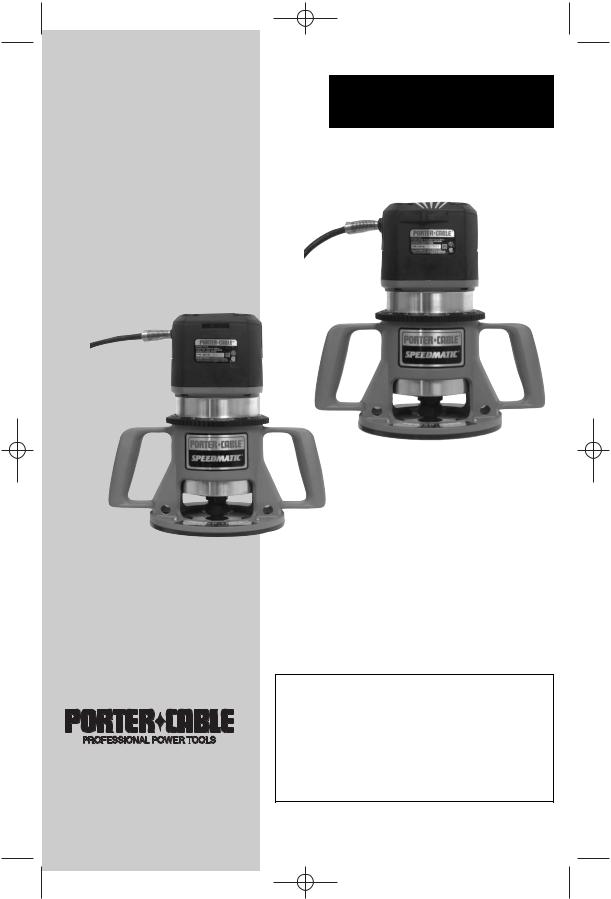Porter-Cable 7519, 7518 User Manual

899750 - 02-14-02.qxd 9/24/02 7:42 AM Page 1
|
ESPAÑOL: PÁGINA 15 |
|
|
FRANÇAISE : PAGE 29 |
|
Instruction |
Double Insulated |
|
Routers |
||
manual |
||
|
To learn more about Porter-Cable visit our website at:
http://www.porter-cable.com
Copyright © 2002 Porter-Cable Corporation
MODEL 7518
Consisting of:
MODEL 75182 Motor
MODEL 75361 Base
MODEL 7519
Consisting of:
MODEL 75192 Motor
MODEL 75361 Base
IMPORTANT
Please make certain that the person who is to use this equipment carefully reads and understands these instructions before starting operations.
The Model and Serial No. plate is located on the main housing of the tool. Record these numbers in the spaces below and retain for future reference.
Model No. ______________________________________
Type ___________________________________________
Serial No. _______________________________________
Part No. 899750 - 02-14-02

899750 - 02-14-02.qxd 9/24/02 7:42 AM Page 2
 WARNING: SOME DUST CREATED BY POWER SANDING, SAWING, GRINDING, DRILLING, AND OTHER CONSTRUCTION ACTIVITIES contains chemicals known to cause cancer, birth defects or other
WARNING: SOME DUST CREATED BY POWER SANDING, SAWING, GRINDING, DRILLING, AND OTHER CONSTRUCTION ACTIVITIES contains chemicals known to cause cancer, birth defects or other
reproductive harm. Some examples of these chemicals are:
·lead from lead-based paints,
·crystalline silica from bricks and cement and other masonry products, and
·arsenic and chromium from chemically-treated lumber.
Your risk from these exposures varies, depending on how often you do this type of work. To reduce your exposure to these chemicals: work in a well ventilated area, and work with approved safety equipment, such as those dust masks that are specially designed to filter out microscopic particles.
GENERAL SAFETY RULES
 WARNING: READ AND UNDERSTAND ALL INSTRUCTIONS. Failure to follow all instructions listed below, may result in electric shock, fire and/or serious personal injury.
WARNING: READ AND UNDERSTAND ALL INSTRUCTIONS. Failure to follow all instructions listed below, may result in electric shock, fire and/or serious personal injury.
SAVE THESE INSTRUCTIONS.
WORK AREA
1.Keep your work area clean and well lit. Cluttered benches and dark areas invite accidents.
2.Do not operate power tools in explosive atmospheres, such as in the presence of flammable liquids, gases, or dust. Power tools create sparks which may ignite the dust or fumes.
3.Keep bystanders, children, and visitors away while operating a power tool. Distractions can cause you to lose control.
ELECTRICAL SAFETY
1.Double insulated tools are equipped with a polarized plug (one blade is wider than the other). This plug will fit in a polarized outlet only one way. If the plug does not fit fully in the outlet, reverse the plug. If it
still does not fit, contact a qualified electrician to install a polarized
outlet. Do not change the plug in any way. Double Insulation 

 eliminates the need for the three wire grounded power cord and grounded power supply system.
eliminates the need for the three wire grounded power cord and grounded power supply system.
2.Avoid body contact with grounded surfaces such as pipes, radiators, ranges and refrigerators. There is an increased risk of electric shock if your body is grounded.
3.Don’t expose power tools to rain or wet conditions. Water entering a power tool will increase the risk of electric shock.
4.Do not abuse the cord. Never use the cord to carry the tools or pull the plug from an outlet. Keep cord away from heat, oil, sharp edges or moving parts. Replace damaged cords immediately. Damaged cords increase the risk of electric shock.
5.When operating a power tool outside, use an outdoor extension cord marked “W-A” or “W”. These cords are rated for outdoor use and reduce the risk of electric shock.
PERSONAL SAFETY
1. Stay alert, watch what you are doing, and use common sense when operating a power tool. Do not use tool while tired or under the influence of drugs, alcohol, or medication. A moment of inattention while operating power tools may result in serious personal injury.
2

899750 - 02-14-02.qxd 9/24/02 7:42 AM Page 3
2.Dress properly. Do not wear loose clothing or jewelry. Contain long hair. Keep your hair, clothing, and gloves away from moving parts.
Loose clothes, jewelry, or long hair can be caught in moving parts.
3.Avoid accidental starting. Be sure switch is OFF before plugging in.
Carrying tools with your finger on the switch or plugging in tools that have the switch ON invites accidents.
4.Remove adjusting keys or wrenches before turning the tool ON. A wrench or a key that is left attached to a rotating part of the tool may result in personal injury.
5.Do not overreach. Keep proper footing and balance at all times.
Proper footing and balance enable better control of the tool in unexpected situations.
6.Use safety equipment. Always wear eye protection. Dust mask, nonskid safety shoes, hard hat, or hearing protection must be used for appropriate conditions.
TOOLS USE AND CARE
1.Use clamps or other practical way to secure and support the workpiece to a stable platform. Holding the work by hand or against your body is unstable and may lead to loss of control.
2.Do not force tool. Use the correct tool for your application. The correct tool will do the job better and safer at the rate for which it is designed.
3.Do not use tool if switch does not turn it ON or OFF. A tool that cannot be controlled with the switch is dangerous and must be repaired.
4.Disconnect the plug from the power source before making any adjustments, changing accessories, or storing the tool. Such preventive safety measures reduce the risk of starting the tool accidentally.
5.Store idle tools out of reach of children and other untrained persons. Tools are dangerous in the hands of untrained users.
6.Maintain tools with care. Keep cutting tools sharp and clean.
Properly maintained tools, with sharp cutting edges are less likely to bind and are easier to control.
7.Check for misalignment or binding of moving parts, breakage of parts, and any other condition that may affect the tool’s operation. If damaged, have the tool serviced before using. Many accidents are caused by poorly maintained tools.
8.Use only accessories that are recommended by the manufacturer for your model. Accessories that may be suitable for one tool may become hazardous when used on another tool.
SERVICE
1.Tool service must be performed only by qualified repair personnel.
Service or maintenance performed by unqualified personnel may result in a risk of injury.
2.When servicing a tool, use only identical replacement parts. Follow instructions in the Maintenance Section of this manual. Use of unauthorized parts or failure to follow Maintenance Instructions may create a risk of electric shock or injury.
SAVE THESE INSTRUCTIONS
3

899750 - 02-14-02.qxd 9/24/02 7:42 AM Page 4
SPECIFIC SAFETY RULES AND SYMBOLS FOR ROUTERS
1.HOLD TOOL BY INSULATED GRIPPING SURFACES WHEN PERFORMING AN OPERATION WHERE THE CUTTING TOOLS MAY CONTACT HIDDEN WIRING OR ITS OWN CORD. Contact with a “live” wire will make exposed metal parts of the tool “live” and shock the operator.
2.TIGHTEN COLLET NUT SECURELY to prevent the bit from slipping.
3.PROVIDE CLEARANCE under workpiece for router bit when throughcutting.
4.CHECK TO SEE THAT THE CORD will not “hang up” during operation.
5.CLEAR THE ROUTER BIT AREA before starting motor.
6.MAINTAIN FIRM GRIP ON TOOL to resist starting torque.
7.KEEP HANDS CLEAR OF BIT WHEN MOTOR IS RUNNING to prevent personal injury.
8.LET THE MOTOR COME TO A COMPLETE STOP before putting the tool down.
9.NEVER TOUCH ROUTER BITS AFTER USE. They may be extremely hot.
10.AVOID “CLIMB-CUTTING”. (See section “USING THE ROUTER” in this manual). “Climb-cutting” increases the chance for loss of control resulting in possible personal injury.
11.DO NOT HAND-HOLD THE ROUTER IN AN UPSIDE-DOWN OR HORIZONTAL POSITION. The motor can separate from the base if not properly attached according to the instructions (See "ATTACHING THE MOTOR TO THE ROUTER") section.
12.SOME WOOD CONTAINS PRESERVATIVES WHICH CAN BE TOXIC.
Take extra care to prevent inhalation and skin contact when working with these materials. Request, and follow, any safety information available from your material supplier.
13. WARNING: There are certain applications for which this tool was designed. Porter-Cable strongly recommends that this tool NOT be modified and/or used for any application other than that for which it was designed. If you have questions relative to its application, DO NOT use the tool until you have written Porter-Cable and we have advised you.
WARNING: There are certain applications for which this tool was designed. Porter-Cable strongly recommends that this tool NOT be modified and/or used for any application other than that for which it was designed. If you have questions relative to its application, DO NOT use the tool until you have written Porter-Cable and we have advised you.
Technical Service Manager
Porter-Cable Corporation
4825 Highway 45 North
Jackson, TN 38305
4

899750 - 02-14-02.qxd 9/24/02 7:43 AM Page 5
SYMBOL |
DEFINITION |
V ........................ |
volts |
A ........................ |
amperes |
Hz ........................ |
hertz |
W ........................ |
watts |
kW ........................ |
kilowatts |
µF ........................ |
microfarads |
l ........................ |
liters |
kg ........................ |
kilograms |
N/cm2 ........................ |
newtons per square centimeter |
Pa ........................ |
pascals |
h ........................ |
hours |
min ........................ |
minutes |
s ........................ |
seconds |
........................ |
alternating current |
3 ........................ |
three-phase alternating current |
3N ........................ |
three-phase alternating current with neutral |
........................ |
direct current |
n0 ........................ |
no load |
........................ |
alternating or direct current |
........................ |
Class II Construction |
........................ |
splash-proof construction |
........................ |
watertight construction |
…/min ........................ |
revolutions or reciprocation per minute |
REPLACEMENT PARTS
When servicing use only identical replacement parts.
MOTOR
Many Porter-Cable tools will operate on either D.C., or single phase 25 to 60 cycle A.C. current and voltage within plus or minus 5 percent of that shown on the specification plate on the tool. Several models, however, are designed for A.C. current only. Refer to the specification plate on your tool for proper voltage and current rating.
CAUTION: Do not operate your tool on a current on which the voltage is not within correct limits. Do not operate tools rated A.C. only on D.C. current. To do so may seriously damage the tool.
EXTENSION CORD SELECTION
If an extension cord is used, make sure the conductor size is large enough to prevent excessive voltage drop which will cause loss of power and possible motor damage. A table of recommended extension cord sizes will be found in this section. This table is based on limiting line voltage drop to 5 volts (10 volts for 230 volts) at 150% of rated amperes.
If an extension cord is to be used outdoors it must be marked with the suffix W-A or W following the cord type designation. For example – SJTW-A to indicate it is acceptable for outdoor use.
5
